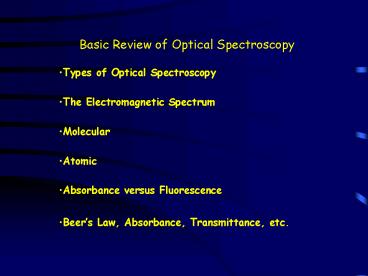Basic Review of Optical Spectroscopy PowerPoint PPT Presentation
1 / 26
Title: Basic Review of Optical Spectroscopy
1
Basic Review of Optical Spectroscopy
- Types of Optical Spectroscopy
- The Electromagnetic Spectrum
- Molecular
- Atomic
- Absorbance versus Fluorescence
- Beers Law, Absorbance, Transmittance, etc.
2
Topics You Should Be Familiar With
- From Physics Courses
- EM radiation and its properties
- Diffraction
- Refraction
- Coherent and incoherent radiation
- Polarization of radiation
- Scattering of radiation
- From Chemistry Courses
- Photoelectric effect
- Electromagnetic spectrum
- Beers Law, etc.
- Quantized states in atoms
- lead to line spectra
- Quantized states in molecules
- lead to broad or continuum spectra
3
Spectroscopic Methods
4
(No Transcript)
5
EMR Properties are Dependent Upon the Media the
Radiation is In!
6
EMR Crossing Media Boundaries is Refracted
7
(No Transcript)
8
Photoelectric Effect
- EMR striking a surface has the ability to eject
an electron from that surface. This is the
Photoelectric effect. - The energy required to eject electrons from the
surface of a material is known as its work
function. - Different materials have different work functions.
9
- When EMR strikes a photocathode (or any
photo-emissive surface), the energy required to
eject and accelerate the photo electron equals
the energy required to break the electron free
from the surface ( ?, work function) plus its
kinetic energy (KE). - This energy is equal to the energy of the
incoming EMR. - E h x ?
10
Dont Forget.
- E h x c/? or E h x ?
- E ? ? x b x c (Beers Law)
- Molar absorptivity is wavelength dependent
- Beers Law can fail at high concentrations!
- The color you see in something that absorbs light
is the complement of what it has absorbed!
11
When Electromagnetic Radiation is Absorbed..
12
Atomic versus Molecular Transitions
- Atomic transitions are usually very discreet
changes of electrons from one quantum state to
another (energy levels, shells, spins, etc.).
What you absorb is what you get back (resonance). - Molecular transitions can involve intermediate
states and therefore resonance is less common!
13
ATOMIC Line SPECTRUM
14
(No Transcript)
15
Molecular SPECTRUM
From http//www.uis.edu/trammell/trammell.html
? ranges for molecular transitions are often 20
nm or more!
16
Some Basic Concepts...
- Why are even line spectra not truly lines?
- They are really broad distributions that are just
over a range of about .01 nm or less. - Some of this (especially with respect to lines)
is due to the uncertainty principle! - Remember, than an atom or molecule does not go
from one distinct energy state to another - it goes from some high probability state to
another high probability state - we can never know the exact energy
- limited by h/?t
- Heisenbergs Uncertainty Principle in action!
- In addition
- Doppler effect
- Variability due to random error in the instrument
components (e.g. wobbly grating, vibration, etc.)
17
When a sample we are analyzing absorbs light
18
Quantitative Relationships for Optical
Spectroscopy
- Beers Law (you should know)
- Definitions
- P0 incident light intensity,
- P transmitted light intensity
- Transmittance
- Absorbance
19
(No Transcript)
20
Instruments for Measuring Absorption of Light.
21
Absorption Spectroscopy (UV-VIS, IR, AAS, etc.)
b
Transmitted Light (P)
Incident Light (Po)
Sample (which in this case has absorbed
violet-blue light. See Harris Table 18.1)
22
Fluorescence and Phosphorescence
Excitation Beam
Emitted Beam
Detector
23
(No Transcript)
24
Resonance Fluorescence
- Resonance Fluorescence
- Usually atomic
- Emitted light has same E as excitation light
- Simpler, atomic systems with fewer energy states
(vs molecules) undergo resonance fluorescence - Not as widely used in analytical chemistry as
non-resonance fluorescence - Hg analysis is one example
Excitation Beam
Emission (identical E)
25
Non-resonance Fluorescence
- Typical of molecular fluorescence
- Large number of excited states
- rotational
- vibrational
- etc..
- Molecules relax by stepping from one state to
another - Resulting emitted light shifts to lower
energies - longer wavelengths lower energy
Excitation Beam
Emission (lower E, longer ? )
26
(No Transcript)

